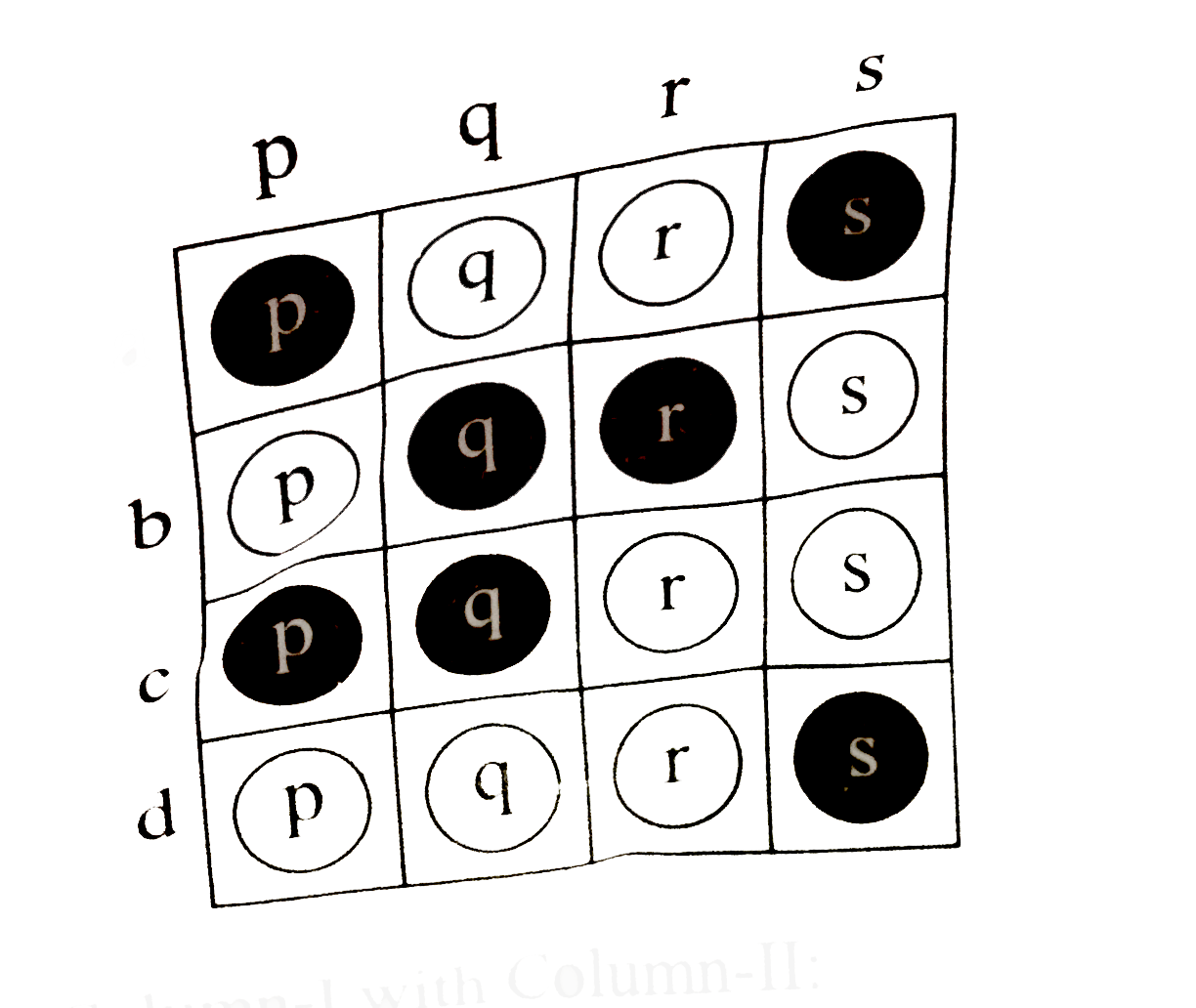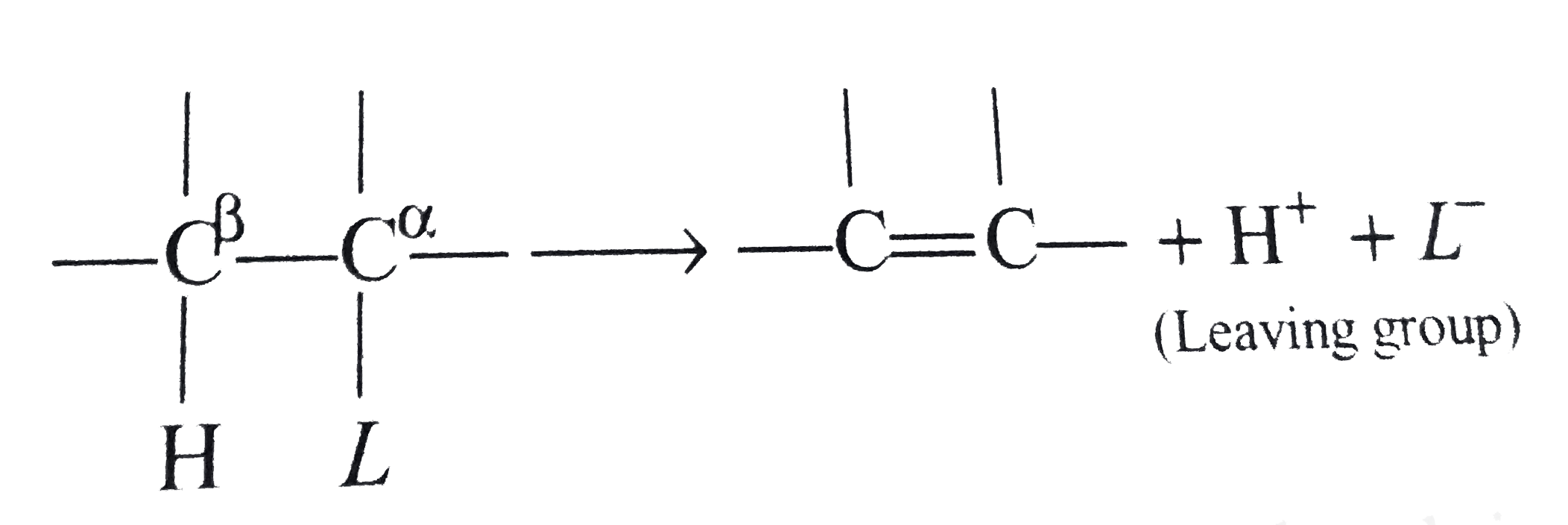The removal of two atoms or groups one generally hydrogen (H+) and the other a leaving group (L−) resulting in the formation of unsaturated compound is known as elimination reaction.

In E1 (elimination) reactions the C-L bond is broken heterolytically (in step 1) to form a carbocation ( as in SN1 reaction) in which (L−) is lost (rate determining step). The carbocation (in step 2) loses a proton from the β− carbon atom by a base (nucleophile) to form an alkene. E1 reaction is favoured in compounds in which the leaving group is at secondar (2∘) or tertiary(3∘) Position.
In E2 (elimination) reactions two sigma bonds are broken and a π−bond is formed simultaneously.E2 reactions occur in one step through a transition state.

E2 reactions are most common in haloalkanes (particulary 1∘) and better the leaving group higher is the E2 reaction. In E2 reactions, both the leaving groups should be antiplaner.
E1cb (Elimination unimolecular conjugate base) reaction involves the removal of proton by a conjugate base (step 1) to produce carbanion which loses a leaving group to form an alkene (step 2) and is a slow step
R2CH−C∣X−R2'+:B−(base)→R2C=CR2
+H−B+X−
this reaction is an example of:
E1 reaction
E2reaction
E1 cb reaction
first order reaction
The correct Answer is:B
Step by step video, text & image solution for The removal of two atoms or groups one generally hydrogen (H^(+)) and the other a leaving group (L^(-)) resulting in the formation of unsaturated compound is known as elimination reaction. In E_(1) (elimination) reactions the C-L bond is broken heterolytically (in step 1) to form a carbocation (" as in "S_(N^(1)) reaction) in which (L^(-)) is lost (rate determining step). The carbocation (in step 2) loses a proton from the beta- carbon atom by a base (nucleophile) to form an alkene. E_(1) reaction is favoured in compounds in which the leaving group is at secondar (2^(@)) or tertiary(3^(@)) Position. In E_(2) (elimination) reactions two sigma bonds are broken and a pi-bond is formed simultaneously.E_(2) reactions occur in one step through a transition state. E_(2) reactions are most common in haloalkanes (particulary 1^(@)) and better the leaving group higher is the E_(2) reaction. In E_(2) reactions, both the leaving groups should be antiplaner. E_(1) cb (Elimination unimolecular conjugate base) reaction involves the removal of proton by a conjugate base (step 1) to produce carbanion which loses a leaving group to form an alkene (step 2) and is a slow step R_(2)CH-underset(X)underset(|)C-R_(2) '+:B^(-) "(base)" to R_(2)C=CR_(2) +H-B+X^(-) this reaction is an example of: by Chemistry experts to help you in doubts & scoring excellent marks in Class 12 exams.
Topper's Solved these Questions
- BOOK - OP TANDONCHAPTER - HALOALKANES AND HALOARENES EXERCISE - Single Interger answer type questions14videos
HALOALKANES AND HALOARENES
- BOOK - OP TANDONCHAPTER - HALOALKANES AND HALOARENES EXERCISE - Matrix -Match Type Questions8videos
HALOALKANES AND HALOARENES
- BOOK - OP TANDONCHAPTER - ELECTROCHEMISTRYEXERCISE - Matrix-Matching Type Question3videos
ELECTROCHEMISTRY
- BOOK - OP TANDONCHAPTER - ISOMERISM (STRUCTURAL AND STEROISOMERISM)EXERCISE - INTEGER7videos
ISOMERISM (STRUCTURAL AND STEROISOMERISM)
Similar Questions
How many monochloro derivatives are possible when 3-methylheptane is subjected to free radical chlorination ?
View SolutionMatch the following
Column IColumn II(Reactants)(Products)(a)CH3CH2CH2CH2Br+KOH(alc)(p)Butan-2-ol(b)CH3CH2CH(Br)CH3+KOH(alc)(q)But-2-ene(trans)(C)(CH3)3C−Br+KOH(alc.)(r) But-1-ene(d)CH3CH2CH2CH2Br+KOH(aq.)(s) 2-Methylprop-1-ene(t)α,β−elimination03:33View SolutionThis section contains 3 questions. Each question contains statement given in two columns which have to be matched. Statement (a, b, c and d) in Column-I have to be matched with statement (p, q, r and s) in Column-II. The answers to these questions have to be appropriately bubbled as illustrated in the following examples :
If the correct matches are (a-p, s), (b-q, r), (c-p, q) and (d-s), then correct bubbled 4×4 matrix should be as follows:

Match the column-I with Column-II :
 03:48View Solution
03:48View SolutionWrite the total number of cyclic structural as well as stereosiomers possible for a compound with the molecular formula C5H10.
View SolutionStatement-1:Compounds having -NR_(3)^(+),-SR_(3)^(+) etc. as leaving groups give Hofmann product in E_(2) elimination. Statement-2: E_(2) elimination is a single step reaction.
05:47View SolutionThe removal of two atoms or groups one generally hydrogen (H+) and the other a leaving group (L−) resulting in the formation of unsaturated compound is known as elimination reaction.

In E1 (elimination) reactions the C-L bond is broken heterolytically (in step 1) to form a carbocation ( as in SN1 reaction) in which (L−) is lost (rate determining step). The carbocation (in step 2) loses a proton from the β− carbon atom by a base (nucleophile) to form an alkene. E1 reaction is favoured in compounds in which the leaving group is at secondar (2∘) or tertiary(3∘) Position.
In E2 (elimination) reactions two sigma bonds are broken and a π−bond is formed simultaneously.E2 reactions occur in one step through a transition state.

E2 reactions are most common in haloalkanes (particulary 1∘) and better the leaving group higher is the E2 reaction. In E2 reactions, both the leaving groups should be antiplaner.
E1cb (Elimination unimolecular conjugate base) reaction involves the removal of proton by a conjugate base (step 1) to produce carbanion which loses a leaving group to form an alkene (step 2) and is a slow step
Isopropyl chloride on heating with concentrated solution of ethanolic KOH gives mainly:03:32View SolutionThe removal of two atoms or groups one generally hydrogen (H^(+)) and the other a leaving group (L^(-)) resulting in the formation of unsaturated compound is known as elimination reaction. In E_(1) (elimination) reactions the C-L bond is broken heterolytically (in step 1) to form a carbocation (" as in "S_(N^(1)) reaction) in which (L^(-)) is lost (rate determining step). The carbocation (in step 2) loses a proton from the beta- carbon atom by a base (nucleophile) to form an alkene. E_(1) reaction is favoured in compounds in which the leaving group is at secondar (2^(@)) or tertiary (3^(@)) Position. In E_(2) (elimination) reactions two sigma bonds are broken and a pi- bond is formed simultaneously. E_(2) reactions occur in one step through a transition state. E_(2) reactions are most common in haloalkanes (particulary 1^(@) ) and better the leaving group higher is the E_(2) reaction. In E_(2) reactions, both the leaving groups should be antiplaner. E_(1) cb (Elimination unimolecular conjugate base) reaction involves the removal of proton by a conjugate base (step 1) to produce carbanion which loses a leaving group to form an alkene (step 2) and is a slow step 2-Bromonbutane on heating with concentrated solution of alcoholic KOH gives major product as :
05:28View SolutionThe removal of two atoms or groups one generally hydrogen (H^(+)) and the other a leaving group (L^(-)) resulting in the formation of unsaturated compound is known as elimination reaction. In E_(1) (elimination) reactions the C-L bond is broken heterolytically (in step 1) to form a carbocation (as in S_(N^(1)) reaction) in which (L^(-)) is lost (rate determining step). The carbocation (in step 2) loses a proton from the beta- carbon atom by a base (nucleophile) to form an alkene. E_(1) reaction is favoured in compounds in which the leaving group is at secondar (2^(@)) or tertiary (3^(@)) Position. In E_(2) (elimination) reactions two sigma bonds are broken and a pi- bond is formed simultaneously. E_(2) reactions occur in one step through a transition state. E_(2) reactions are most common in haloalkanes (particulary 1^(@) ) and better the leaving group higher is the E_(2) reaction. In E_(2) reactions, both the leaving groups should be antiplaner. E_(1) cb (Elimination unimolecular conjugate base) reaction involves the removal of proton by a conjugate base (step 1) to produce carbanion which loses a leaving group to form an alkene (step 2) and is a slow step 2-Bromopentane is heated with potassium ethoxide in ethanol. The major product obtained is :
View SolutionThe removal of two atoms or groups one generally hydrogen (H+) and the other a leaving group (L−) resulting in the formation of unsaturated compound is known as elimination reaction.

In E1 (elimination) reactions the C-L bond is broken heterolytically (in step 1) to form a carbocation (as inSN1 reaction) in which (L−) is lost (rate determining step). The carbocation (in step 2) loses a proton from the β− carbon atom by a base (nucleophile) to form an alkene. E1 reaction is favoured in compounds in which the leaving group is at secondar (2∘) or tertiary(3∘) Position.
In E2 (elimination) reactions two sigma bonds are broken and a π−bond is formed simultaneously.E2 reactions occur in one step through a transition state.

E2 reactions are most common in haloalkanes (particulary 1∘) and better the leaving group higher is the E2 reaction. In E2 reactions, both the leaving groups should be antiplaner.
E1cb (Elimination unimolecular conjugate base) reaction involves the removal of proton by a conjugate base (step 1) to produce carbanion which loses a leaving group to form an alkene (step 2) and is a slow step Neopentyl bromide undergoes dehydrohalogenation to give alkene even though it has no β−hydrogen.This is due to :View SolutionIn S1N reaction, the first step involves the formation of -
View SolutionConsider the statements for given reaction

1. In the first step, there is breaking of C - O bond
2. The second step is SN2 reaction
3. There is retention of configuration in the first step
4. There is inversion of configuration in the second step04:26View SolutionThe carbocation fomed in S_(N^1) reaction of alkyl halide in the slow step is …………………… .
02:59View SolutionAlkylhalides have polar C-X bond and undergo nucleophilic substitution reactions. These give a variety of products with nucleophiles such as −OH,−OR,−NH2,−CN,−NC,−NO2,−ONO,RCOO−, etc. They undergo mainly two types of nucleophilic substitution reactions, SN1 and SN2. SN1 reactions are two steps reactions which proceed through the formation of carbocations while SN2 reactions are one step reaction which proceeds through the formation of transition state. The stability of carbocation and transition state determine the reactivity of alkyl halides.
Arrange the following in the increasing order of reactivity towards SN2 reaction:
 05:12View Solution
05:12View SolutionAlkylhalides have polar C-X bond and undergo nucleophilic substitution reactions. These give a variety of products with nucleophiles such as -OH, -OR, -NH_(2), -CN, -NC, -NO_(2), -ONO, RCOO^(-) , etc. They undergo mainly two types of nucleophilic substitution reactions, S_(N)1 and S_(N)2 . S_(N)1 reactions are two steps reactions which proceed through the formation of carbocations while S_(N)2 reactions are one step reaction which proceeds through the formation of transition state. The stability of carbocation and transition state determine the reactivity of alkyl halides. Which out of S_(N)1 or S_(N)2 results into inversion of configuration?
02:10View SolutionAlkylhalides have polar C-X bond and undergo nucleophilic substitution reactions. These give a variety of products with nucleophiles such as −OH,−OR,−NH2,−CN,−NC,−NO2,−ONO,RCOO−, etc. They undergo mainly two types of nucleophilic substitution reactions, SN1 and SN2. SN1 reactions are two steps reactions which proceed through the formation of carbocations while SN2 reactions are one step reaction which proceeds through the formation of transition state. The stability of carbocation and transition state determine the reactivity of alkyl halides.
Arrange the following in the increasing order of reactivity towards SN2 reaction:
 02:10View Solution
02:10View Solution

